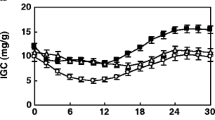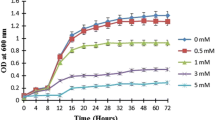Abstract
In the recent years, yeasts have evolved as potent bioremediative candidates for the detoxification of xenobiotic compounds found in the natural environment. Candida sp. are well-studied apart from Saccharomyces sp. in heavy metal detoxification mechanisms. In the current study, Candida parapsilosis strain ODBG2, Candida sp. strain BANG3, and Candida viswanathii strain ODBG4 were isolated from industrial effluents and contaminated ground water, and were studied for their metal tolerance. Among these three isolates, the metal tolerance was found to be more towards Lead (Pb 2 mM), followed by Cadmium (Cd 1.5 mM) and Chromium [Cr(VI), 1 mM]. On further exploring the involvement of primary defensive enzymes in these isolates towards metal tolerance, the anti-oxidative enzyme superoxide dismutase was found to be prominently high (25% with respect to the control) during first 24 h of metal–isolate interaction. The Catalase enzyme assay was observed to have increased enzyme activity at 48 h. It also triggered the activity of peroxidases, which lead to the increase in reduced glutathione in the organism by 0.87–1.9-fold as a metal chelator and also as a second-line defensive molecule. The exoproteome profile showed the early involvement (exponential growth phase) of secreted proteins (low-molecular-weight) of about ~ 40–45 kDa under Cd and Pb stress (0.5 mM). The exoproteome profiling under heavy metal stress in Candida parapsilosis strain ODBG2 and Candida viswanathii strain ODBG4 is the first report.





Similar content being viewed by others
Abbreviations
- Pb:
-
Lead
- Cd:
-
Cadmium
- mM:
-
Millimolar
- SOD:
-
Superoxide dismutase
- CAT:
-
Catalase
- GSH:
-
Glutathione
- YPDA:
-
Yeast peptone dextrose agar
- HM:
-
Heavy metal (s)
- MIC:
-
Minimal inhibitory concentration
- ITS:
-
Internal transcribe sequences
- PCR:
-
Polymerase chain reaction
- TBE:
-
Tris–borate EDTA
- BLAST:
-
Basic local alignment search tool
- MEGA:
-
Molecular evolutionary genetics analysis
- PMSF:
-
Phenylmethylsulfonyl fluoride
- H2O2 :
-
Hydrogen peroxide
- DTNB:
-
5, 5′-Dithiobis(2-nitrobenzoic acid)
- SDS-PAGE:
-
Sodium dodecyl sulphate polyacrylamide gel electrophoresis
- CHAPS:
-
3-Cholamidopropyl dimethylammonio 1-propanesulfonate
- DTT:
-
Dithiothreitol
References
Amoakwah E, Ahsan S, Rahman MA, Asamoah E, Essumang DK, Ali M, Islam KR (2020) Assessment of heavy metal pollution of soil-water-vegetative ecosystems associated with artisanal gold mining. Soil Sediment Contam 29(7):788–803. https://doi.org/10.1080/15320383.2020.1777936
Azcon R, del Carmen PM, Roldán A, Barea JM (2010) Arbuscular mycorrhizal fungi, Bacillus cereus, and Candida parapsilosis from a multi-contaminated soil alleviate metal toxicity in plants. Microb Ecol 59(4):668–677. https://doi.org/10.1007/s00248-009-9618-5
Balsalobre L, De Silóniz MI, Valderrama MJ, Benito T, Larrea MT, Peinado JM (2003) Occurrence of yeasts in municipal wastes and their behaviour in presence of cadmium, copper and zinc. J Basic Microbiol Int J Biochem Physiol Genet, Morphol Ecol Microorg 43(3):185–193. https://doi.org/10.1002/jobm.200390021
Bandyopadhyay U, Das D, Banerjee RK (1999) Reactive oxygen species: oxidative damage and pathogenesis. Curr Sci 77(5):658–666. http://www.jstor.org/stable/24102839
Bansal S, Garg M, Chatterjee M (2019) Evaluation of heavy metal resistance profile of Candida parapsilosis. Indian J Biotechnol 18:64–68
Bhavya G, Kumar CRS, Swati K, Geetha N (2015) In search of industrial clean-up clients; evaluation of heavy metal tolerability of rhizospheric Trichoderma. Int J Innov Sci Eng Technol 2:948–952
Bradford MM (1976) A rapid and sensitive method for the quantitation of microgram quantities of protein utilizing the principle of protein-dye binding. Anal Biochem 72(1–2):248–254. https://doi.org/10.1016/0003-2697(76)90527-3
Chai L, Huang M, Cao X, Liu M, Huang Y (2019) Potential metal-binding ability of proteins in the extracellular slime of Laccaria bicolor exposed to excessive Cu and Cd. Environ Sci Pollut Res 26(20):20418–20427. https://doi.org/10.1007/s11356-019-05201-2
Chen G, Zhou Y, Zeng G, Liu H, Yan M, Chen A, Guan S, Shang C, Li H, He J (2015a) Alteration of culture fluid proteins by cadmium induction in Phanerochaete chrysosporium. J Basic Microbiol 55(2):141–147. https://doi.org/10.1002/jobm.201300398
Chen A, Shang C, Zeng G, Chen G, Shao J, Zhang J, Huang H (2015b) Extracellular secretions of Phanerochaete chrysosporium on Cd toxicity. Int Biodeterior Biodegrad 105:73–79. https://doi.org/10.1016/j.ibiod.2015.08.017
Chu D (2018) Effects of heavy metals on soil microbial community. In: IOP Conference series: earth and environmental science, vol 113(1). IOP Publishing, pp 012009
Congeevaram S, Dhanarani S, Park J, Dexilin M, Thamaraiselvi K (2007) Biosorption of chromium and nickel by heavy metal resistant fungal and bacterial isolates. J Hazard Mater 146(1–2):270–277. https://doi.org/10.1016/j.jhazmat.2006.12.017
Dey P, Malik A, Mishra A, Singh DK, von Bergen M, Jehmlich N (2020) Mechanistic insight to mycoremediation potential of a metal resistant fungal strain for removal of hazardous metals from multimetal pesticide matrix. Environ Pollut 262:114255. https://doi.org/10.1016/j.envpol.2020.114255
Ellman GL (1959) Tissue sulfhydryl groups. Arch Biochem Biophys 82(1):70–77
Fauchon M, Lagniel G, Aude JC, Lombardia L, Soularue P, Petat C, Marguerie G, Sentenac A, Werner M, Labarre J (2002) Sulfur sparing in the yeast proteome in response to sulfur demand. Mol Cell 9(4):713–723. https://doi.org/10.1016/S1097-2765(02)00500-2
Feldman D, Kowbel DJ, Glass NL, Yarden O, Hadar Y (2017) A role for small secreted proteins (SSPs) in a saprophytic fungal lifestyle: ligninolytic enzyme regulation in Pleurotus ostreatus. Sci Rep 7(1):1–13. https://doi.org/10.1038/s41598-018-21904-x
Felsenstein J (1985) Confidence limits on phylogenies: an approach using the bootstrap. Evol 39(4):783–791. https://doi.org/10.1111/j.1558-5646.1985.tb00420.x
Geetha N, Bhavya G, Abhijith P, Shekhar R, Dayananda K, Jogaiah S (2020) Insights into nanomycoremediation: Secretomics and mycogenic biopolymer nanocomposites for heavy metal detoxification. J Hazard Mater 409:124541. https://doi.org/10.1016/j.jhazmat.2020.124541
Gharieb MM, Gadd GM (2004) Role of glutathione in detoxification of metal (loid) s by Saccharomyces cerevisiae. Biometals 17(2):183–188. https://doi.org/10.1023/B:BIOM.0000018402.22057.62
Ilyas S, Rehman A, Ilyas Q (2017) Heavy metals induced oxidative stress in multi-metal tolerant yeast, Candida sp. PS33 and its capability to uptake heavy metals from wastewater. Pak J Zool 49(3):769–775
Ilyas S, Rehman A, Coelho AV, Sheehan D (2016) Proteomic analysis of an environmental isolate of Rhodotorula mucilaginosa after arsenic and cadmium challenge: Identification of a protein expression signature for heavy metal exposure. J Proteom 141:47–56. https://doi.org/10.1016/j.jprot.2016.04.012
Ilyas S, Rehman A, Varela AC, Sheehan D (2014) Redox proteomics changes in the fungal pathogen Trichosporon asahii on arsenic exposure: identification of protein responses to metal-induced oxidative stress in an environmentally-sampled isolate. PLoS ONE 9(7):e102340. https://doi.org/10.1371/journal.pone.0102340
Itoh H, Iwasaki M, Sawada N, Takachi R, Kasuga Y, Yokoyama S, Onuma H, Nishimura H, Kusama R, Yokoyama K, Tsugane S (2014) Dietary cadmium intake and breast cancer risk in Japanese women: a case-control study. Int J Hyg Environ Health 217(1):70–77. https://doi.org/10.1016/j.ijheh.2013.03.010
Kachiprath B, Solomon S, Jayanath G, Philip R (2019) Mangrove microflora as potential source of hydrolytic enzymes for commercial applications. IJMS 48(5):678–684
Kengaiah J, Nandish SKM, Ramachandraiah C, Shivaiah A, Vishalakshi GJ, Paul M, Santhosh MS, Shankar RL, Sannaningaiah D (2020) Protective effect of tamarind seed coat ethanol extract on eryptosis induced by oxidative stress. Biochem Mosc 85(1):119–129. https://doi.org/10.1134/S0006297920010113
Khosropour E, Attarod P, Shirvany A, Pypker TG, Bayramzadeh V, Hakimi L, Moeinaddini M (2019) Response of Platanus orientalis leaves to urban pollution by heavy metals. J for Res 30(4):1437–1445. https://doi.org/10.1007/s11676-018-0692-8
Kumar S, Stecher G, Li M, Knyaz C, Tamura K (2018) MEGA X: molecular evolutionary genetics analysis across computing platforms. Mol Biol Evol 35(6):1547. https://doi.org/10.1093/molbev/msy096
Laemmli UK (1970) Cleavage of structural proteins during the assembly of the head of bacteriophage T4. Nature 227(5259):680–685. https://doi.org/10.1038/227680a0
Lazarova N, Krumova E, Stefanova T, Georgieva N, Angelova M (2014) The oxidative stress response of the filamentous yeast Trichosporon cutaneum R57 to copper, cadmium and chromium exposure. Biotechnol Biotechnol Equip 28(5):855–862
Lin X, Xu X, Zeng X, Xu L, Zeng Z, Huo X (2017) Decreased vaccine antibody titers following exposure to multiple metals and metalloids in e-waste-exposed preschool children. Environ Pollut 220:354–363. https://doi.org/10.1016/j.envpol.2016.09.071
Lin Y, Ye Y, Hu Y, Shi H (2019) The variation in microbial community structure under different heavy metal contamination levels in paddy soils. Ecotoxicol Environ Saf 180:557–564. https://doi.org/10.1016/j.ecoenv.2019.05.057
Mohankumar K, Hariharan V, Rao NP (2016) Heavy metal contamination in groundwater around industrial estate vs residential areas in Coimbatore India. J Clin Diagn Re JCDR 10(4):BC05
Moreno A, Demitri N, Ruiz Baca E, Vega González A, Polentarutti M, Cuéllar Cruz M (2019) Bioreduction of precious and heavy metals by Candida species under oxidative stress conditions. Microb Biotechnol 12(6):1164–1179. https://doi.org/10.1111/1751-7915.13364
Mostafa H, Pala A, Högel J, Hlavac M, Dietrich E, Westhoff MA, Nonnenmacher L, Burster T, Georgieff M, Wirtz CR, Schneider EM (2016) Immune phenotypes predict survival in patients with glioblastoma multiforme. J Hematol Oncol 9(1):1–14. https://doi.org/10.1186/s13045-016-0272-3
Muneer B, JIqbal M, Shakoori FR, Shakoori AR (2013) Tolerance and biosorption of mercury by microbial consortia: potential use in bioremediation of wastewater. Pak J Zool 45(1):247–254
Pradhan A, Herrero-de-Dios C, Belmonte R, Budge S, Lopez Garcia A, Kolmogorova A, Lee KK, Martin BD, Ribeiro A, Bebes A, Yuecel R (2017) Elevated catalase expression in a fungal pathogen is a double-edged sword of iron. PLoS Pathog 13(5):e1006405. https://doi.org/10.1371/journal.ppat.1006405
Rehman A, Anjum MS (2011) Multiple metal tolerance and biosorption of cadmium by Candida tropicalis isolated from industrial effluents: glutathione as detoxifying agent. Environ Monit Assess 174(1):585–595. https://doi.org/10.1007/s10661-010-1480-x
Santos DK, Resende AH, de Almeida DG, Soares da Silva RDCF, Rufino RD, Luna JM, Banat IM, Sarubbo LA (2017) Candida lipolytica UCP0988 biosurfactant: potential as a bioremediation agent and in formulating a commercial related product. Front Microbiol 8:767. https://doi.org/10.3389/fmicb.2017.00767
Satapute P, Kamble MV, Adhikari SS, Jogaiah S (2019) Influence of triazole pesticides on tillage soil microbial populations and metabolic changes. Sci Total Environ 651:2334–2344. https://doi.org/10.1016/j.scitotenv.2018.10.099
Schieber M, Chandel NS (2014) ROS function in redox signaling and oxidative stress. Curr Biol 24(10):R453–R462 (PMID: 24845678)
Selvam RM, Nithya R, Devi PN, Shree RB, Nila MV, Demonte NL, Thangavel C, Maheshwari JJ, Lalitha P, Prajna NV, Dharmalingam K (2015) Exoproteome of Aspergillus flavus corneal isolates and saprophytes: identification of proteoforms of an over secreted alkaline protease. J Proteom 115:23–35. https://doi.org/10.1016/j.jprot.2014.11.017
Shaji E, Santosh M, Sarath KV, Prakash P, Deepchand V, Divya BV (2021) Arsenic contamination of groundwater: A global synopsis with focus on the Indian Peninsula. Geosci Front 12(3):101079. https://doi.org/10.1016/j.gsf.2020.08.015
Tamura K, Nei M (1993) Estimation of the number of nucleotide substitutions in the control region of mitochondrial DNA in humans and chimpanzees. Mol Biol Evol 10(3):512–526. https://doi.org/10.1093/oxfordjournals.molbev.a040023
Thornhill SG, Kumar M, Vega LM, McLean RJ (2017) Cadmium ion inhibition of quorum signalling in Chromobacterium violaceum. Microbiology 163(10):1429–1435. https://doi.org/10.1099/mic.0.000531
White TJ, Bruns T, Lee SJWT, Taylor J (1990) Amplification and direct sequencing of fungal ribosomal RNA genes for phylogenetics. PCR Protoc Guide Methods Appl 18(1):315–322
Wu X, Xiong E, Wang W, Scali M, Cresti M (2014) Universal sample preparation method integrating trichloroacetic acid/acetone precipitation with phenol extraction for crop proteomic analysis. Nat Protoc 9(2):362–374. https://doi.org/10.1038/nprot.2014.022
Zeng GM, Chen AW, Chen GQ, Hu XJ, Guan S, Shang C, Lu LH, Zou ZJ (2012) Responses of Phanerochaete chrysosporium to toxic pollutants: physiological flux, oxidative stress, and detoxification. Environ Sci Technol 46(14):7818–7825. https://doi.org/10.1021/es301006j
Zhang S, Zhang X, Chang C, Yuan Z, Wang T, Zhao Y, Yang X, Zhang Y, La G, Wu K, Zhang Z (2016) Improvement of tolerance to lead by filamentous fungus Pleurotus ostreatus HAU-2 and its oxidative responses. Chemosphere 150:33–39. https://doi.org/10.1016/j.chemosphere.2016.02.003
Acknowledgements
Authors are thankful for Department of Studies in Biotechnology, University of Mysore, Mysuru for facilities provided. The authors also extend their thanks to facilities available at Laboratory of Plant Healthcare and Diagnostics, PG Department of Biotechnology and Microbiology, Karnatak University, Dharwad.
Funding
The authors received no financial support for this research work.
Author information
Authors and Affiliations
Contributions
Supervision of research work: NG and SJ. Bench work: GB. Data validation: GB, NG, KH, and SJ. Figures and charts: GB, NG, and SJ. Contributed reagents/chemicals: NG. Wrote the original manuscript: GB, NG, and SJ. All the authors read and approved the manuscript.
Corresponding authors
Ethics declarations
Conflict of interest
The authors do not have any competing interest in the submitted work.
Additional information
Communicated by Erko Stackebrandt.
Publisher's Note
Springer Nature remains neutral with regard to jurisdictional claims in published maps and institutional affiliations.
Supplementary Information
Below is the link to the electronic supplementary material.
Rights and permissions
About this article
Cite this article
Bhavya, G., Hiremath, K.Y., Jogaiah, S. et al. Heavy metal-induced oxidative stress and alteration in secretory proteins in yeast isolates. Arch Microbiol 204, 172 (2022). https://doi.org/10.1007/s00203-022-02756-6
Received:
Revised:
Accepted:
Published:
DOI: https://doi.org/10.1007/s00203-022-02756-6




